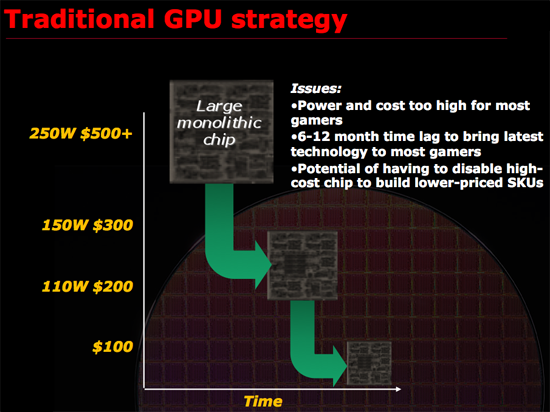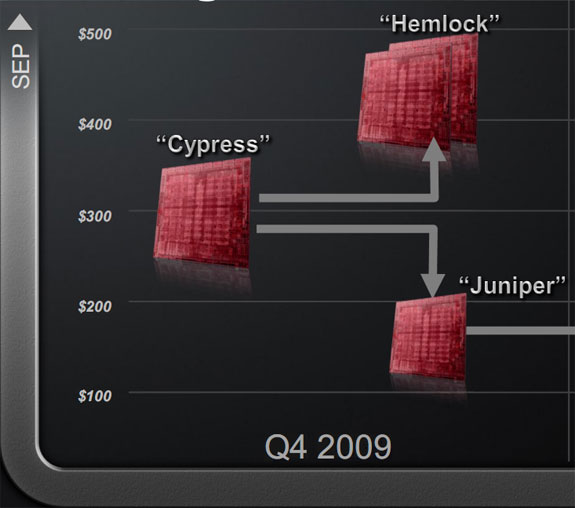The RV870 Story: AMD Showing up to the Fight
by Anand Lal Shimpi on February 14, 2010 12:00 AM EST- Posted in
- GPUs
What Made it All Ok: 4 GPUs in < 6 Months
Through a lot of hard work and sacrifice, even on Carrell’s part, ATI cut the RV870 from as much as 22mm on a side down to roughly 18mm x 18mm. The problem is that RV770 was around 16mm on a side. The RV870 was still too big.
Carrell wanted to cut it down even more, but two things changed his mind. First, in order to build 870 in the space of a 770 ATI would have to cut out much more from the chip than Carrell originally tought. One of the things that would have to go was some of the shader core.
In order to run the GDDR5 memory at the sort of data rates that ATI was targeting for the 5870 the analog PHYs on the chip had to grow considerably. At 16mm on a side ATI would either have to scale back memory bandwidth or eat into the shader core area. Either way we would’ve had a slower chip.
I asked Carrell if 16mm on a side would’ve made the RV870 $100 cheaper at launch, putting it on par with the RV770 launch prices. He said no. I didn’t find out why until much later, but I’ll save that story for another time.
Sacrificing performance to meet the 16mm x 16mm die size targets wasn’t going to happen, but what ultimately convinced Carrell to go with a larger die this time around was something that ATI didn’t get nearly enough praise for: the ability to launch 4 different 40nm DirectX 11 GPUs in less than 6 months.
Remember that Carrell’s beef with building the biggest GPU possible is that it takes too long for the majority of customers to get access to derivatives of that GPU. Look at how long it took G80 or GT200 to scale down. And who knows when we’ll see $150 Fermi/GF100 derivatives.

But ATI Engineering promised two things. First, that Cypress would have a successor called Juniper that would be ready around the same time. Secondly, two more GPUs would follow and the whole stack will be done and out in less than 6 months. ATI came close in 2008 with 3 GPUs in 3 months, but the fourth member of the 4000 series didn’t show up until April of 2009.
It wasn’t an impossible feat. ATI does have concurrent design teams and a lot of engineering resources in India/China. By working on Juniper in tandem with Cypress, assuming there were no show stopping bugs, ATI could exploit efficiencies in two teams effectively working on the same hardware (Juniper was just half a Cypress).
The idea of taking such a huge risk made Carrell uncomfortable. Running two GPU designs in parallel, for the same family of chips, is risky. If everything works out perfectly, you get two chips out at the same time. If it doesn’t, you’ve just tied up two design teams on one product generation. A slip here would give ATI its own Fermi.
What ultimately sold Carrell was the fact that engineering told him that they believed they could pull it off. Carrell believes in people. He believes if you expect the best out of those around you, then that’s what you’ll get. He couldn’t reconcile his beliefs with doubting the schedule engineering was feeding him. Carrell nervously signed off and the Evergreen stack was born.

Cypress and Juniper were delivered nearly at the same time. In fact, Juniper was ready a bit earlier and was sampled to developers months before ATI launched the 5000 series. Cedar and Redwood followed, not to mention a dual-Cypress board that became the Radeon HD 5970. And all of this was done and ready in less than 6 months (the chips themselves were all ready within 4 months).
When the smoke cleared ATI had new DirectX 11 parts at $600, $400, $300, $200, $150, $100 and $60. The Windows 7/DirectX 11 market bulge just got serviced.










132 Comments
View All Comments
papapapapapapapababy - Sunday, February 14, 2010 - link
Ok, ok, great read, but i have to hate a bit, 1,2,3 GO! hey Carrell here is my top priority feature for your next PRS1 -Drivers that dont suck ass-
"The performance was still a problem and the RV740 was mostly lost as a product" ...
the fuk? the 4770 is the BEST card i ever had, PERIOD. cheap, fast, cool, the perfect RV770, thanks !
bla bla Carrell "He’s single handedly responsible for getting Eyefinity included in the Evergreen stack"
Meh? who gives a sht. , Carrell give me console like gpu scaling, so we can finally play crysis at 1080p, another one for that PRS
"Carrell went to David Glenn, head of software engineering at ATI and asked"
drivers that dont suck, please?
" There were also game compatibility concerns that made ATI not interested in the software approach"
Lol i wonder why? i think i know why. Hardware, hardware, what about the software,Carrell?
ok, thats it. not much to complain this time, flawless job ati guys
f0d - Sunday, February 14, 2010 - link
long time reader/first time postingive never felt the need to post anything but with this article i really wanted to say:
"thank you"
the insights we get in these articles is amazing (i also read the first when it was done)
i like the "no technical or maketing bs" writing of this story and all the little pieces of information like with the eyefinity story and sideport
please do as much of these type of stories as possible - it must be difficult to talk to the right people and get the right information out of them and also be allowed to publish it but it makes a great read
Robert Kooijman - Sunday, February 14, 2010 - link
Awesome article Anand!Also specially created an account to inform you how impressed I am with articles like these. A real treat these behind the scenes stories in non-marketing language. Keep 'm coming, compliments!
- Friday, February 19, 2010 - link
bravowhen do the (tech industry) book's come out??
Kryten - Sunday, February 14, 2010 - link
Informative, interesting, inspirational, edifying and very well written. Here's hoping for more research and articles like this.greenguy - Sunday, February 14, 2010 - link
Hi Anand, I've been reading your stuff for 3 years or so, I just created an account to tell you how awesome that article was. Very nice work. This sort of content is why I read Anandtech. (My other favorite articles have been the SSD articles and the i5-750 article.)I especially like to hear about AMD/ATI - I like having a serious competitor to Intel out there, and I commend AMD for opening up their graphics card documentation. I hope that they continue to fund the Linux driver development (both open and closed source). I also hope their CPU division can put the heat on Intel again, especially on the low power front.
at80eighty - Sunday, February 14, 2010 - link
Anand I was just telling someone yesterday how I wish you guys got more popularity for the different approach you guys havebetween articles like this and the new beta Bench tab - I think I'm really looking forward to your proposed changes you promised this year
insurgent - Sunday, February 14, 2010 - link
I had a really great time reading the article, thanks!Markstar - Sunday, February 14, 2010 - link
Also a big thank you from me for this wonderful article.It's exactly these kind of stories that I hope to find here every morning when I start the day.
JimmiG - Sunday, February 14, 2010 - link
Well the late changes would explain why the RV870 isn't "perfect" like the 770 was. At every price point except at the high-end, it delivers more features, but less or similar performance as the previous generation. For example the 5770 is slower than the 4870, the 5750 is about the same speed and price as the 4850 and so on. Also at the high-end it's more expensive than the 4800-series ever were - the 4870 was only $299 at launch, the 5870 is still at least $399. By this month in 2009, the 4870 was down to $249!